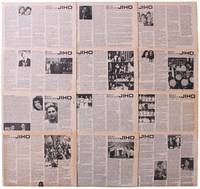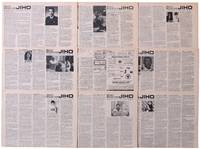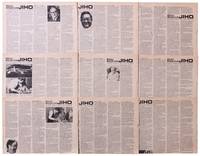Rocky Mountain JIHO [Run of 42 issues]
- SIGNED
- Denver, Colorado: [Sadako Tsubokawa (Jan-Mar)]/[Eiji Makino (Mar-Nov)]/[Eiichi and Yoriko Imada (Nov-Dec)], 1978
Denver, Colorado: [Sadako Tsubokawa (Jan-Mar)]/[Eiji Makino (Mar-Nov)]/[Eiichi and Yoriko Imada (Nov-Dec)], 1978. Very good. 17” x 10 7/8”. Newsprint. Pp. 4. Publication sequence: Vol. 16, Nos. 37-50 (Jan 11 – Apr 19 1978); Vol. 17, Nos. 1-16 (Apr 26 – Aug 30 1978), 18-20 (Sep 20 – Oct 11 1978), 22-31 (Oct 18 – Dec 20 1978). Generally very good or better: folded horizontally at center, presumably as issued; postal markings and stamps of former ownership to bottom corner of each issue; one with a tiny closed tear not affecting any content; a few with faint creases or light edge wear; lightly toned.
This is a large group of issues of a rare weekly newspaper that served the Japanese American community of Denver for over 40 years, the Rocky Mountain JIHO. Printed in both English and Japanese, JIHO covered immigration concerns as well as social and community events, and ran a plethora of illustrated ads for local nikkei-owned businesses.
Japanese immigration to Denver began in the 1880s, saw an influx of railroad and mine workers from 1903 to 1908, and exploded in the 1940s with those fleeing West Coast incarceration; for a time the city was even considered the “unofficial Japanese capital of the United States.” The population expanded again after World War II with the closure of the Camp Amache incarceration center near Granada, Colorado. Centered in the Larimer Street district (also known as Nihonmachi, or Japantown), banned from opening businesses elsewhere, emigres formed a tight-knit community – living, working and worshiping in close proximity. While several newspapers had served the community before the war, by the 1970s there was only this one. JIHO was founded in 1962 by Yozan and Sadako Tsubokawa; Yozan was editor/journalist, his wife Sadako managed local advertising and their daughters helped with the weekly printing and distribution. When Yozan died in 1970, Sadako took over ownership. She kept the paper running until March 1978, when she sold it to Eiji Makino, a Tokyo magazine publisher who had moved to Denver in 1976. When he fell ill just eight months later JIHO made it into the hands of another immigrant couple, Eiichi and Yoriko Imada. Despite having no prior experience in publishing, the Imadas ran the paper from November 1978 to February 2007.
The present collection comprises a near-complete run of the paper's 1978 issues, and notably documents both takeovers of ownership. Though just 42 issues are present, we note a few numbering inconsistencies, and it's likely that the run lacks fewer than three issues, if any at all. The layout and general content remain unchanged throughout the year, despite new editorship; each issue has news and community updates in English on the front page and in Japanese on the other three, with plenty of photographic images and illustrated ads in both languages throughout. JIHO is chock-full of calendars and coverage of community events, along with regular updates on immigration policies. We read of “Songfests” at the Denver Buddhist Temple, allocations for a Japanese “niwa” at the Denver Botanic Gardens, the “16th Annual Simpson Church Nisei Bowling Tournament” and “A Request to Area Nikkei” from the “Mile Hi JACL Chapter” for book suggestions for the “Japanese section” at the University of Colorado library. There was also occasional national and international news, reporting on a “Nikkei Church with a Mission in Big Town, U.S.A.” (New York City), and the “double burden” on “temporarily displaced” children of Japanese nationals attending both public and Nihongo Gakko Japanese schools in Belgium.
JIHO frequently lauded the efforts of area nikkei, such as Susumu Karaki, director of Colorado State University's Solar Energy Applications Laboratory, and Rick Takahashi, who coached “cerebral palsy and amputee students” for the National Handicapped Ski Races at Winter Park. Cathy Morimoto was “said to be the first woman from the U.S. assigned to work” at the International Atomic Energy Agency in Vienna, young Joanne Nukaya led a fundraising project for the International Student Exchange Program, and two residents attended the World Buddhist Women's Convention in São Paolo, held concurrently to celebrate the 70th anniversary of Japanese immigration to Brazil. Regular columns covered the “Teen Scene” as well as local, school, state and national sports. Blurbs and great photographic images revealed parties, awards ceremonies, meetings of JACL chapters and elders' groups, theater and musical events, exhibits of Japanese art, locals' travel adventures, weddings, graduations, memorial services and much more. There were also dozens of illustrated advertisements for restaurants, markets, florists, art and antiques galleries, insurance agents, banks and martial arts studios, owned and operated by those of Japanese descent. A few issues ran want ads and a few promoted an “Equal Housing Opportunity” in homes for sale acquired by the Veterans Administration.
Interestingly, these issues show postal and former ownership markings of the Pacific Asian Coalition of San Jose, California (PAC). Now part of the Association of Asian Pacific Community Health Organizations, per a 1978 report, PAC was “the Asian and Pacific American coalition for mental health and other human services, the only one of its kind with a national scope.”
A rare and revelatory run documenting Japanese Americans in Colorado. OCLC shows only limited holdings of physical and microfilm issues at three Colorado institutions, and none have these issues.
This is a large group of issues of a rare weekly newspaper that served the Japanese American community of Denver for over 40 years, the Rocky Mountain JIHO. Printed in both English and Japanese, JIHO covered immigration concerns as well as social and community events, and ran a plethora of illustrated ads for local nikkei-owned businesses.
Japanese immigration to Denver began in the 1880s, saw an influx of railroad and mine workers from 1903 to 1908, and exploded in the 1940s with those fleeing West Coast incarceration; for a time the city was even considered the “unofficial Japanese capital of the United States.” The population expanded again after World War II with the closure of the Camp Amache incarceration center near Granada, Colorado. Centered in the Larimer Street district (also known as Nihonmachi, or Japantown), banned from opening businesses elsewhere, emigres formed a tight-knit community – living, working and worshiping in close proximity. While several newspapers had served the community before the war, by the 1970s there was only this one. JIHO was founded in 1962 by Yozan and Sadako Tsubokawa; Yozan was editor/journalist, his wife Sadako managed local advertising and their daughters helped with the weekly printing and distribution. When Yozan died in 1970, Sadako took over ownership. She kept the paper running until March 1978, when she sold it to Eiji Makino, a Tokyo magazine publisher who had moved to Denver in 1976. When he fell ill just eight months later JIHO made it into the hands of another immigrant couple, Eiichi and Yoriko Imada. Despite having no prior experience in publishing, the Imadas ran the paper from November 1978 to February 2007.
The present collection comprises a near-complete run of the paper's 1978 issues, and notably documents both takeovers of ownership. Though just 42 issues are present, we note a few numbering inconsistencies, and it's likely that the run lacks fewer than three issues, if any at all. The layout and general content remain unchanged throughout the year, despite new editorship; each issue has news and community updates in English on the front page and in Japanese on the other three, with plenty of photographic images and illustrated ads in both languages throughout. JIHO is chock-full of calendars and coverage of community events, along with regular updates on immigration policies. We read of “Songfests” at the Denver Buddhist Temple, allocations for a Japanese “niwa” at the Denver Botanic Gardens, the “16th Annual Simpson Church Nisei Bowling Tournament” and “A Request to Area Nikkei” from the “Mile Hi JACL Chapter” for book suggestions for the “Japanese section” at the University of Colorado library. There was also occasional national and international news, reporting on a “Nikkei Church with a Mission in Big Town, U.S.A.” (New York City), and the “double burden” on “temporarily displaced” children of Japanese nationals attending both public and Nihongo Gakko Japanese schools in Belgium.
JIHO frequently lauded the efforts of area nikkei, such as Susumu Karaki, director of Colorado State University's Solar Energy Applications Laboratory, and Rick Takahashi, who coached “cerebral palsy and amputee students” for the National Handicapped Ski Races at Winter Park. Cathy Morimoto was “said to be the first woman from the U.S. assigned to work” at the International Atomic Energy Agency in Vienna, young Joanne Nukaya led a fundraising project for the International Student Exchange Program, and two residents attended the World Buddhist Women's Convention in São Paolo, held concurrently to celebrate the 70th anniversary of Japanese immigration to Brazil. Regular columns covered the “Teen Scene” as well as local, school, state and national sports. Blurbs and great photographic images revealed parties, awards ceremonies, meetings of JACL chapters and elders' groups, theater and musical events, exhibits of Japanese art, locals' travel adventures, weddings, graduations, memorial services and much more. There were also dozens of illustrated advertisements for restaurants, markets, florists, art and antiques galleries, insurance agents, banks and martial arts studios, owned and operated by those of Japanese descent. A few issues ran want ads and a few promoted an “Equal Housing Opportunity” in homes for sale acquired by the Veterans Administration.
Interestingly, these issues show postal and former ownership markings of the Pacific Asian Coalition of San Jose, California (PAC). Now part of the Association of Asian Pacific Community Health Organizations, per a 1978 report, PAC was “the Asian and Pacific American coalition for mental health and other human services, the only one of its kind with a national scope.”
A rare and revelatory run documenting Japanese Americans in Colorado. OCLC shows only limited holdings of physical and microfilm issues at three Colorado institutions, and none have these issues.


![Rocky Mountain JIHO [Run of 42 issues]](https://d3525k1ryd2155.cloudfront.net/h/045/966/1656966045.0.x.jpg)


